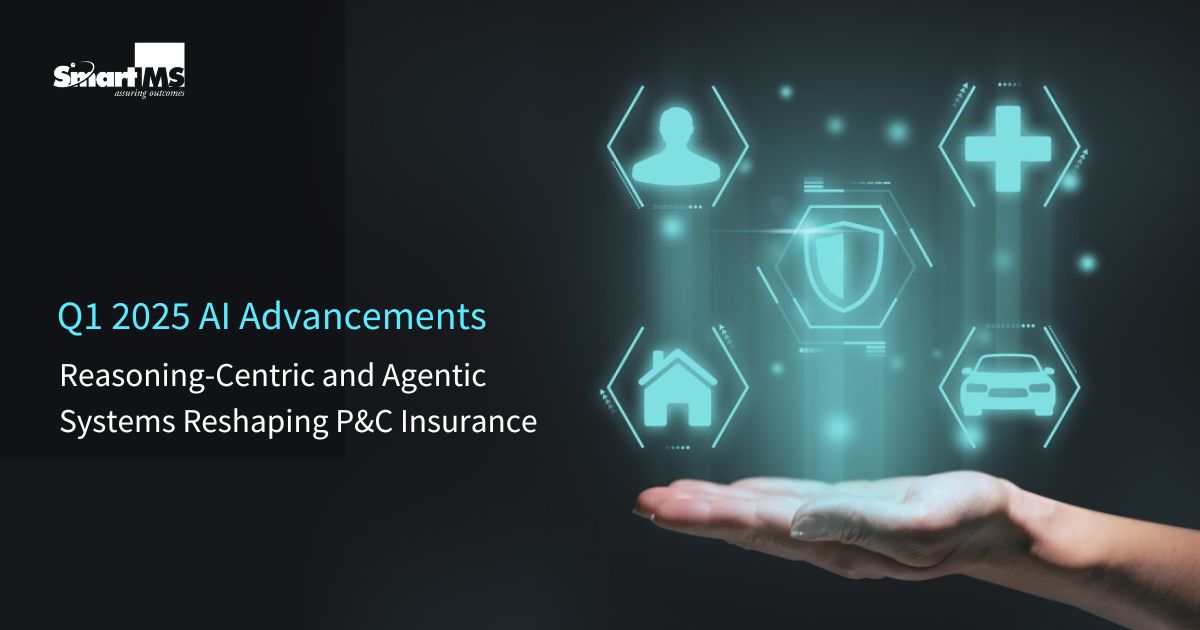From January to March 2025, generative AI has rapidly evolved, finding additional applications across industries—not least in Property & Casualty (P&C) insurance. Large Language Models (LLMs) are increasingly capable of advanced reasoning, enabling more accurate underwriting decisions and faster claims processing. Simultaneously, new “agentic” frameworks are emerging that grant these models greater autonomy and adaptability—particularly relevant in a field where risk assessments and regulatory compliance must be managed seamlessly.
This overview highlights two major trends—reasoning-centric LLMs and agentic architectures—while also noting how these capabilities are already integrated into Xymphony, our product suite designed to simplify P&C operations around customer sales & service.
Let’s read more about it.
1. Surge in Reasoning-Centric Models
A clear hallmark of recent LLM developments has been the focus on “reasoning-centric” architectures, which move beyond simple pattern completion to more robust forms of logical and contextual understanding. This is especially important in P&C insurance, where complex policy language and guidelines can create pitfalls if misread or misapplied.
Rather than merely echoing past examples, next-generation models employ “chain-of-thought” reasoning. Picture a scenario: a homeowner files a claim for severe storm damage, but the incident also involves potential liability if, for instance, a fallen tree affected a neighboring property.
A reasoning-centric LLM would parse the multiple policy provisions—property coverage, liability coverage, local regulations—and examine each logical step in detail. While end-users might not see the entire thought process, surfacing it internally helps detect discrepancies early, reducing the chance of errors.
Another emerging approach involves hybrid symbolic-ML methods. In underwriting, for example, a language model might parse large volumes of unstructured data—prior claims, geospatial risk factors, property codes—while a symbolic layer ensures the model’s conclusions align with stringent underwriting guidelines. This dual-layer approach not only boosts accuracy but also provides a transparent audit trail for regulators and customers alike, an especially critical feature given the stakes of coverage decisions.
Many development teams now deploy “selective consensus” mechanisms to further reduce errors, re-running the model or referencing specialized mini models (e.g., for fraud detection) when inconsistencies arise. This iterative verification loop works like a built-in peer-review process, significantly curbing “hallucination,” where models confidently produce incorrect answers.
By prioritizing interpretability and logical structure, these reasoning-centric architectures herald a shift away from scaling purely for size. In the P&C world, improved reasoning translates into more reliable risk analysis, reduced settlement disputes, and an enhanced customer experience—all of which align with how Xymphony’s AI modules are designed to handle policy and claims data comprehensively and accurately.
2. Agentic Architectures & Autonomous Systems
The second major trend shaping AI in early 2025 is the rise of agentic architectures—systems that can operate with a degree of autonomy rather than relying on human guidance for every step. In P&C insurance, the ability to automate complex tasks like risk assessments, claims triage, and portfolio optimization can lead to remarkable efficiency gains.
Agentic systems rely on contextual planning states, maintaining a running awareness of completed actions, pending tasks, and overarching goals. For example, during a high volume of claims filed after a large-scale hailstorm, an agent could autonomously sift through policy databases, match coverage details to weather data, and even dispatch adjusters to high-risk areas—all with minimal human oversight. By allowing such tasks to unfold automatically, operational bottlenecks are reduced, and skilled personnel can focus on the more nuanced aspects of claim resolution or underwriting decisions.
A notable advantage of agentic architectures is the potential for specialized multi-agent collaboration. Imagine an underwriting process where one agent specializes in interpreting financial solvency data, while another tackles geospatial risk modeling. These agents share insights, collaboratively refining their recommendations until they converge on a proposal for coverage limits, endorsements, and premium amounts. This mirrors the structure of expert teams in an insurance organization but at a more rapid and scalable pace.
Naturally, greater autonomy raises concerns around regulatory compliance and ethical oversight—both vital in P&C insurance. Agentic systems often include “circuit-breakers” or supervisory checkpoints to flag high-risk decisions (e.g., excessively large payouts or suspicious claims) for human review. This ensures that while the system maximizes operational throughput, it remains aligned with industry regulations and corporate governance standards.
Taken together, agentic architectures represent a leap toward more dynamic, responsive insurance operations. By harnessing these frameworks within solutions like Xymphony, insurers can streamline workflows and gain higher-level insights into risk, all while maintaining robust oversight that protects both policyholders and the business.
3. Spotlight on the “Humanity’s Last Exam” Benchmark
Within the research community, a new benchmark—informally referred to as “Humanity’s Last Exam”—has gained popularity for gauging an AI’s capacity for broad, human-like reasoning. Discussed in a recent technical report (arXiv:2501.14249) and tracked by agi.safe.ai, it tests models with ambiguous queries, real-world complexities, and nuanced scenarios that might mirror P&C insurance challenges, where obscure clauses or contradictory statements often arise.
As of early 2024, most language models could barely manage a 3% success rate on this demanding benchmark. By March 2025, top-tier systems have surpassed 18%—still far from mastery, but a striking leap that underscores the rapid convergence of better architectures and refined training methods. These improvements translate directly into more reliable performance in specialized contexts like insurance, where large volumes of textual data and complex risk profiles intersect.
While critics argue that an 18% success rate is insufficient for fully automated decision-making in high-stakes environments, proponents highlight the benchmark’s primary value: it tracks how quickly AI is gaining the capacity to handle ambiguity and context-heavy reasoning. For P&C carriers seeking to adopt or enhance AI-driven functionalities, such tests offer a valuable lens into the evolving sophistication—and limitations—of the technology.
Conclusion
From advanced reasoning strategies to autonomous agentic systems, AI’s influence on P&C insurance operations grows more robust by the day. These trends tackle industry-specific challenges—like dissecting complicated policy clauses or swiftly triaging high volumes of claims—while also raising essential questions about transparency, oversight, and accountability.
Already implemented within Xymphony, these capabilities empower insurers to expedite workflows, reduce errors, and deliver more responsive service to customers. Even as benchmarks like “Humanity’s Last Exam” underscore the ongoing journey toward more general AI, today’s systems are already powerful enough to catalyze a pivotal shift in how insurers manage risk, handle claims, and forge customer trust.
Ready to harness the power of AI for your P&C operations?
Explore how Xymphony can transform underwriting, claims, and risk management today.



